by Winding Pathways | Oct 10, 2024 | Nature, Water Resources
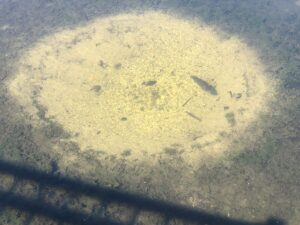
The male protects the eggs from predators.
All Fish are awesome! Rich learned that firsthand. As a young boy, he spent hours watching male sunfish guard their saucer-shaped nests in the shallow water of Cedar Lake.
Sunfish
Sunfish are awesome! This huge family of fish flip-flops the way nature normally defines child-rearing. In most animals, the female gets the work. That’s not how sunfish families operate.
Male sunfish provide primary child care. He makes a nest in shallow water every spring over a sandy or pebbly bottom. When it’s finished a female hovers over it and releases hundreds of eggs as he releases millions of tiny sperm. Hopefully egg meets sperm and the now fertilized egg nestles into the sandy nest.
Tough Life
Life’s not easy. Small fish, and especially small sunfish, love feasting on the eggs. Mom departs with no child-rearing duties, while Dad stands by chasing off any intruder intent on a meal of eggs.
Where Sunfish Live
There are sunfish in nearly every body of relatively warm fresh water from Canada down to the Gulf of Mexico. Even renowned gamefish, like large and smallmouth bass, are in the sunfish family. The most commonly known is the bluegill. Most sunfish species are on the small side. They’re lumped together as panfish because they’re easy to catch, prolific, and tasty.
Fisherman’s Life
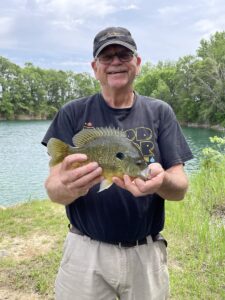
Awesome bluegill!
Rich had the good fortune to grow up next to a New Jersey Lake, where he watched fish and learned how to catch them. A love of fish led to his earning a degree in fishery biology and an early career working with fish in Alaska.
All Fish Are Awesome!
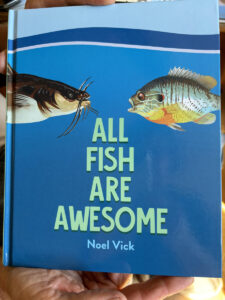
Book by Noel Vick
Not all kids are lucky enough to live near a lake, but a new book will help them learn that All Fish Are Awesome. That’s the title of Noel Vick’s new book. Its colorful art shows many amazing fish species of both fresh and saltwater, with a bit of text about each one. It’s a great book for parents or grandparents to share with a child perched in their lap. Then, on a pleasant spring day bring that kid to a nearby lake to spot sunfish nests and maybe even wet a line. It might ignite a lifeline passion for fish and fishing or even lead to a career.
Where to Buy the Book
The book’s available at Amazon or blueballoonbooks.com.
by Winding Pathways | Sep 19, 2024 | (Sub)Urban Homesteading, 1080 Labyrinth Blog, Garden/Yard, Nature, Wonderment
Partnership with Sustainable Landscape Solutions Creates Natural Beauty
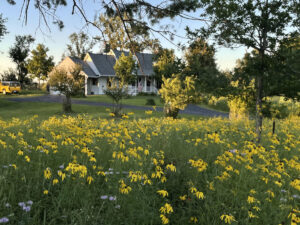
Brilliant flowers
When we bought our home near Cedar Rapids in 2010 we had a vision to transform the yard that had been sprayed and manicured by its former owner into a wondrous place, brimming with natural beauty and fascinating wildlife. It would be a delightful yard with prairie and savanna wildflowers bouncing in the breeze, and goldfinches and swallowtail butterflies winging over. We sought to create natural beauty.
We have years of ecological restoration experience. Rich had been restoring prairies and oak savannas since 1975 in his position as executive director of two nature centers. Like Rich, Marion is an inspired naturalist and a labyrinth expert. Together we had managed our former home for diversity, but the new property offered more space.
Beginning almost immediately, we planted prairies in portions of our front and back yards and worked with Linn County Roads to restore prairie in the nearby road ditch. This helped hold runoff water that could percolate into the ground.
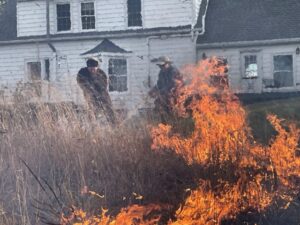
Working together.
Fortunately, we have experience managing fire. Rich is a former US Forest Service Hot Shot (wild firefighter) and we’ve used prescribed burns to help nurture the prairie. Burning has helped us resurrect native plants and wildlife.
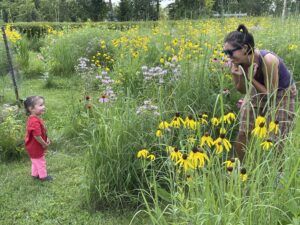
August – Joy is a part of labyrinths.
In their largest prairie Marion crafted the Phoenix Harmony Labyrinth. This is a five-circuit, dual-entry path to the center where people can enjoy a bur oak and be surrounded by prairie grasses and forbs. She welcomes people to play and encourages anyone wishing for moments of contemplation to visit and walk its curving paths between blooming prairie plants. Her labyrinth is listed on the international labyrinth locator registry.
How Sustainable Landscape Solutions
Helped the Pattersons
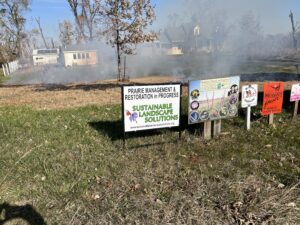
Several organizations and businesses are collaborating to create and manage the prairie.
We needed help with our newer projects. “We wanted to transform a hilly patch of our front lawn into a prairie rich in wildflowers and fewer tall prairie grasses. The site was a long-established conventional lawn composed of exotic grasses,” said Rich. “That’s a challenging environment to establish prairie. I’ve established prairies on lawns before by broadcasting seeds and following up with prescribed burns. But, it’s a slow process. We wanted to speed up restoration and needed help killing the turf and preparing the soil,” he added.
In 2020 we hired Sustainable Landscape Solutions to do the prep by first spraying the existing turf and later working the soil. Pattersons took it from there and planted a seed mix they purchased from Pheasants Forever. It’s called their Leopold Mix and contains seeds of 82 species of native prairie wildflowers.
Patience
It takes prairie time to mature. A year after planting we had a few blooms. The next year a few more. In its third year, it began to look like a prairie, and by its fifth growing season, the area was a magnificent spread of colorful flowers fluttering in the summer breeze. Alive with bumblebees, butterflies, and other insects, it was rich with life.
Next Steps
Four years later we decided to pursue a different sort of property upgrade. The 2020 Derecho did a job on a cozy nook next to the garage. “We wanted to transform a weedy nook south of our house into a delightful place to sit on cool spring and fall days where the sun would warm us. We worked with Virginia Hayes of Sustainable Landscape Solutions to come up with a patio plan that allows us and our visitors to sit and enjoy our thriving natural landscapes.
Patience, Again
Multiple rains delayed the project as Sustainable Landscapes worked diligently to catch up on already scheduled, and now rain-delayed projects. The new patio was crafted in July 2024. “It’s an example of how our company was able to work with homeowners to create a vision and gorgeous yard. Pattersons had much restoration knowledge but we’re happy to help people less experienced transform their yards into areas of natural beauty,” said Sean Pearl of Sustainable Landscapes.
-

-
Weeds overtook the area
-
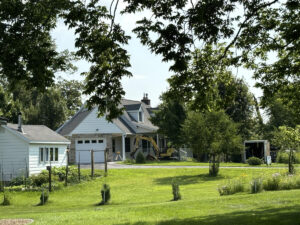
-
Small evergreens have replaced fallen Derecho trees.
-
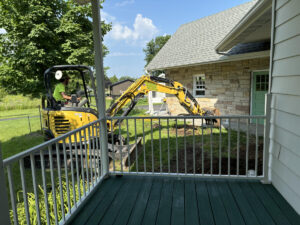
-
First removing dirt.
-
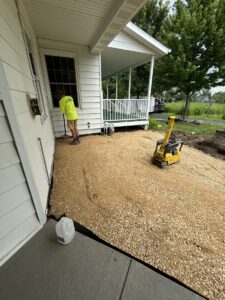
-
Next steps
-
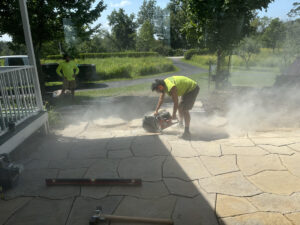
-
Dusty job
-

-
Water flows away

Coming together
Now, in early autumn, the nook is coming together nicely and we look forward to sharing it, the yard, and the labyrinth with others.
A Little More About Labyrinths
The Patterson’s labyrinth is created in a tallgrass prairie but these can be built in many ways, including in formal landscaping. “Many are made of bricks or pavers that enable a walker to negotiate the winding pathway,” said Marion. “Ours has a wide grassy path with borders of prairie grasses and forbs that change seasonally.” Labyrinths are structures with a path that winds to a center. Each time walkers follow the path around the center is called a circuit. Walkers find that the winding path slows down their minds and they can settle into a more relaxed space. Because of the natural setting, many walkers comment on how they recall times in nature as youth. Patterson is available to help landowners create labyrinths.
Blessings of the Changing Landscapes
We welcome visitors to our Winding Pathways website and to see our prairies.
by Winding Pathways | Aug 22, 2024 | Garden/Yard, Nature, Wonderment
Guest Blogger – Jacqueline Hull
Have you ever tried something fun as a gardener? Well, I have. My curiosity wondered if it were possible to root the head of a pineapple.
We love fresh pineapple. The head has to be cut off then the sides to get to the juicy pieces. Then, we stash the severed pieces in the compost pot for future use in the garden.

Will the pineapple take?
One day, after my husband, Peter, dissected our fresh pineapple, I retrieved the top piece and placed it into some moist potting soil. I made sure the soil was damp each day as I waited for it to root. After a time, to my delight, I discovered the head had indeed grown roots and was holding tightly to the soil.
For several years I fertilized and watered this pineapple as the spears grew larger and taller. I also transplanted it to a huge glazed pot.
Peeking down into the center of the plants one day, I saw a teeny tiny fruit that had developed. It kept growing and growing and eventually, a soft, golden color appeared in its greenery. It had about seven inches of fruit and I knew it was ready to be picked.
To our delight when we harvested the pineapple, the inside was sweet and juicy.
Now, we wait for the two that are growing on the porch to ripen. One has a fruit and we anticipate the other to develop its fruit.
Our adventure continues as we try to grow onions from pieces with roots and wonder if we could do the same with celery…maybe!
Editor’s note: Share your growing experiments with us on the comments page.
by Winding Pathways | Jul 25, 2024 | Nature, Travel/Columns, Water Resources
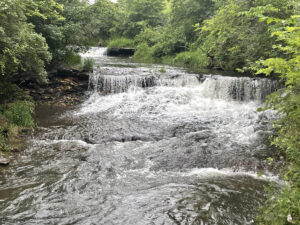
Tumbling waters
There it is! A Waterfall. There’s a second. Wow, just upstream is a third. Three waterfalls in one Iowa stretch of stream! How can that be in such a flat state?
Waterfalls bring mental images of water tumbling down steep hillsides where it plunges hundreds of feet downward. We’ve marveled at tall falls in many states including Hawaii, Nebraska, Washington, Indiana, Minnesota, New Hampshire, and New Jersey. But Rich had discovered the waterfall trio in an unexpected state – Iowa – and in an equally unexpected part of the state.
-
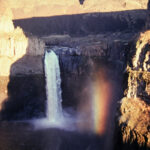
-
Water tumbles through a narrow cataract.
-
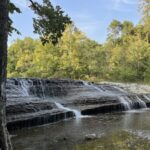
-
Indiana surprise
-
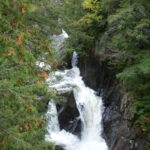
-
North Shore Falls
Briggs Woods County Park Delight
Amid north central Iowa’s vast level corn and bean fields he discovered the three cascades after a short hike near Webster City. More than rushing water caught his eyes. Fish were trying to leap up the rushing torrent. “It brought back memories of salmon leaping Brooks Falls in Alaska. These were small fish of an unknown species. Watching them was great fun,” he said. The three falls are close together in Hamilton County’s Briggs Woods Park and all it takes to enjoy them is a short hike on an easy trail.
Driftless Area
Iowa isn’t flat. Mostly it’s rolling terrain, but the state’s northeast corner features downright steep slopes. It’s the Driftless area, where most of Iowa’s falls gurgle and tumble down into clear running trout streams.
Touring Iowa’s Waterfalls
Seeing the Briggs Woods falls gave us a waterfall bug, so a few weeks later we drove north from our Cedar Rapids home. A region of Karst topography, the Driftless boasts dozens of clear water trout streams and several impressive falls.
-
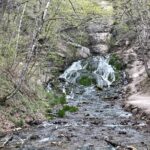
-
Karst topography helps create waterfalls.
-
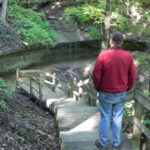
-
Bridal veil falls, at Pikes Peak
Decorah Area
Decorah is Iowa’s waterfall epicenter. Twin Springs bubbles quietly from the ground and flows down past a campground. Siewer’s and Dunnings Springs hurl an impressive amount of cool clear water over rocks close to downtown. (Note, the travel Iowa site uses an apostrophe (‘) for Siewer’s Spring but not for Dunnings). It’s easy to park close to all of these. Viewing nearby Malanaphy Springs is worth the mile walk. It’s the best known of several falls that send water to the Upper Iowa River.
-
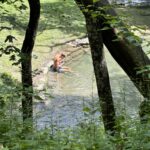
-
Cooling waters.
-

-
Water tumbles from the ledges
-
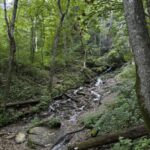
-
A popular stop for canoeists on the Upper Iowa River.
-
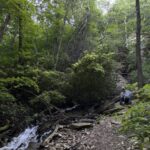
-
Hike through quiet woods.
Other Waterfalls
Other Waterfalls? Yup. Depending on who you ask and what you consider a waterfall, the Hawkeye state has dozens of them. Many aren’t natural waterfalls. Many are human-made cascades tumbling down a dam spillway, but the ones mentioned above are genuine nature-made falls.
Benefits of Seeking Out Waterfalls
We love falls for their beauty. Visiting them has a side benefit. They are in Iowa’s most beautiful terrain. A waterfall viewing trip gives the opportunity to see these unexpected Iowa sights, hike challenging trails, enjoy local eateries, and overnight in nearby campgrounds or one of the dozens of bed and breakfasts scattered about rural and small-town Iowa.
Where to Find Waterfalls
A helpful resource for finding falls is Travel Iowa – 14 Wonderful Waterfalls in Iowa.
by Winding Pathways | Jul 11, 2024 | Nature, Travel/Columns, Wonderment
Winding Pathways is near the edge of town, making it easy to drive into the country and enjoy rural views. Mostly our car traverses Iowa’s abundant corn and soybean fields, but two recent trips gave exceptional views of different vegetation that bloomed in bright lavender under the June sun.
The Lavender Farm
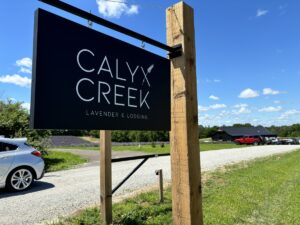
Entry to Calyx Creek
One recent June afternoon as we drove through conventional crops an amazing and delightful view appeared. Shades of purple and stunning white blanketed the undulating land accenting the deep green of cultivated crops. We had discovered Calyx Creek Lavender and Lodging a few miles west of North Liberty, Iowa. Rows of lavender in various stages of growth surrounded us as we entered the main building to find various products made of this unusual plant.
The warm, calming fragrance of the oils of this subtle herb wafted through the shop. Dried bunches hung from racks. Informational signs in front of gleaming machines shared highlights of the distillation process. Soaps, oils, candles, carpet freshener, lavender-infused stuffies and slippers, beverages, and tasty treats beckoned visitors to sample and buy. A lemonade mix was a hit among patrons on this warm summer day. “It smells so good inside, and this lemonade is super!” commented one man, cupping the cool drink in his hands.
-

-
An array of products awaits.
-

-
Slushys are popular.
Tours and Lodging
Part of the experience includes tours, opportunities to harvest and enjoy in your own home, and overnight lodging!
We walked among fields of blooming lavender to two of the several cabins available for rent. The two, built on pedestals, are well-equipped. All the lodgings offer a chance to “get away” while being close to nature. We climbed the stairs, sat on the small cabin’s deck, and took in the rural views of expansive fields of lavender. Peace flowed through us.
-
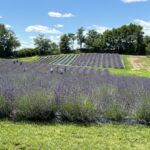
-
Strolling through lavender fields
-
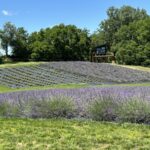
-
Peaceful overnights
Calyx Creek Lavender and Lodging is a fun place to visit, especially during the early summer blooming time. More information at: Calyx Creek LLC, 1722 255th St. NW, Oxford, IA 52322.
Phone: (319) 900-5992
Where Does Lavender Originate?
Lavender is native to the Mediterranean Region of southern Europe and Northern Africa. It has so many uses that it has been planted around the world. It has become problematic in Australia but is a valued product in North America. Lavender has a long, documented, and storied history with applications for improved health, reducing anxiety, moderating the effects of bug bites and burns, and as an antiseptic/anti-inflammatory agent. The latter is useful in the flu season. Gardeners can grow lavender at home. A helpful resource on how to grow it is at Garden Design.
More Rural Views
The fields of lavender at Calyx Creek are carefully groomed, providing a contrast to our discovery the next day. Secondary roads stairstep through Iowa, replete with rural views of corn, beans, oats, cattle, and goats. We were making our way to a reconstructed prairie south of Waterloo, Iowa
The Irvine Prairie
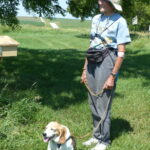
A happy duo.
That day Cathy Irvine led us through her prairie dotted with pale purple coneflowers, purple prairie clover, and blooms of different hues. Common yellowthroats serenaded us as red-winged blackbirds winged around this amazing place.
We admired the beauty of one of Iowa’s largest reconstructed prairies and were humbled to have Cathy Irvine share part of her day with us. Some people are so inspiring. She’s one.
After years of conventional farming, her vision took her land in a different direction. She’d turn the clock back and restore her land to how it looked and functioned before the first plow turned the original prairie into row crops. She didn’t do this on a whim. For decades Cathy had thought about, researched, attended programs on, and connected with experts on prairies. She knew that reconstructing the native habitat with its diverse plants and animals was right to do.
-
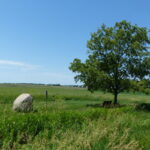
-
Glacial boulders are part of the landscape.
-
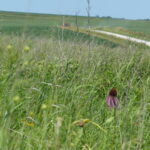
-
Contrast
Collaboration
Working with the Iowa Natural Heritage Foundation and the University of Northern Iowa Tallgrass Prairie Center she placed much of her farm in conservation easement and collaborated on restoring it to its native vegetation in honor of her late husband, David. Being in a conservation easement means that it will remain a wild and gorgeous prairie forever, no matter who might own the land in the future.
Iowa’s Rich Heritage
Iowa’s original prairie hosted upwards of 300 plant species on each acre that agriculture transformed into vast monocultures of soybeans and corn. Cathy’s land was in row crops until she decided to give her property to the Tallgrass Prairie Center under a conservation easement. Starting in 2018 the Prairie Center began planting upwards of 100 native species an acre and followed it up with prescribed burning, weeding, and even plugging in more native species.
Cathy, the Tallgrass Prairie Center, and the Iowa Natural Heritage Foundation welcome visitors to experience what much of Iowa once looked like. It’s a place to enjoy dancing prairie grasses and forbs on a breezy summer day, listen to birds trilling across the expanse, watch butterflies forage on blooms, and be inspired by the quiet beauty resulting from a transformation springing from Cathy’s vision and cooperative effort.
The Prairie is located at 1173 55th Street, Dysart, Iowa. Several mowed trails radiate outward from a small parking lot. A bench nestled under a spreading tree offers shade and a place to reflect.
-
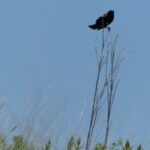
-
Calling out territory
-
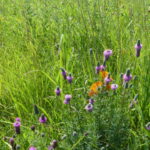
-
colorful forbs
-
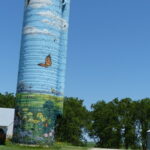
-
Colorful silo
Best Times To Enjoy Prairie Flowers
Prairie flowers bloom throughout the growing season but during midsummer’s heat, the colors are most amazing. However, the prairie is magical in any season. We enjoy our small reconstructed prairies through all seasons and especially in the summer months.
The Lavender Farm meticulously cultivates a useful plant not native to Iowa and the Irvine Prairie carefully stewards a rewilded prairie. Both are gorgeous.
For more information, visit the Tallgrass Prairie Center and the Iowa Natural Heritage Foundation websites.
The Color Purple
Our eyes had the good fortune to view purple lavender one day and purple prairie flowers the next, but purple is a tricky color, at least for some people. Like around 10% of men and boys, Rich isn’t able to see it or see it as folks with normal color vision can. “Red and shades of red are hard for me to see. Purple is nearly impossible. It seems odd but I can see the color but know it looks very different to me than to most folks. If someone asks me what purple looks like I have to say, I’m not sure since I can’t really see it,” he said. “Fortunately I can see blue and yellow prairie blooms and magnificent butterfly milkweed flowers that seem to glow a bright orange,” he added.
Winding Pathways encourages readers to take in any of their native habitat to appreciate our green island home – Earth.
by Winding Pathways | Jul 4, 2024 | (Sub)Urban Homesteading, Bugs, Garden/Yard, Garden/Yard, Nature
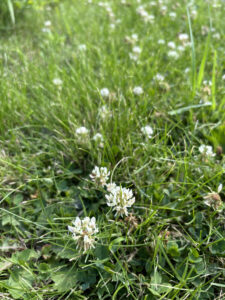
Mowers pass over low-growing clovers.
We recently discovered an amusing irony created by one of the most common lawn plants – white clover.
Sometimes called Dutch Clover, this low-growing plant graces unsprayed lawns in temperate regions across the globe. Normally, we discourage nonnative plants at Winding Pathways, but clover is an exception.
Although native to Eurasia, it’s not invasive. This important forage legume is likely the most widespread in the world. Diminutive clover is so low growing our mower passes right over its dainty flowers. Our friendly cottontail bunnies may seem to be eating grass, but actually, they’re feasting on clover. So are beneficial insects. As its flowers add beauty to the lawn and feed animals, clover’s roots pump nitrogen into the soil, helping other plants grow.
The irony
AI detected our Internet search for clover information. We began getting computer ads from landscaping companies encouraging us to hire them to kill our clover “and other weeds” in our lawn. No way!
Many people spend good money to poison beneficial lawn plants. They expose themselves, their pets, and anyone who walks on the lawn to toxic substances.
Maintaining a Healthy Bed of White Clover
White clover tends to gradually decline over the years. We’ve noticed this at Winding Pathways. To give it a boost we buy white clover seeds and sprinkle them on the lawn during cool months, especially on bare spots. Seed can be purchased online and in stores where hunters shop. These stores sell seeds beneficial to wildlife, and hunters often plant them to boost food for deer and wild turkeys.
-
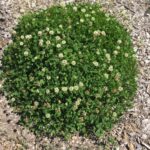
-
Clover can be manicured.
-
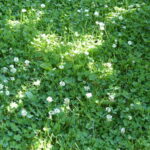
-
Sunlight on a clover lawn forms a cross.
-
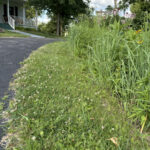
-
Dutch White Clover is low-growing.
Rewards
We have healthy lawns, rich with nitrogen. And, on summer mornings and evenings, we sit in our front porch’s rocking chairs watching bumble bees and bunnies foraging on our blooming white clovers. Thanks, clover.
-
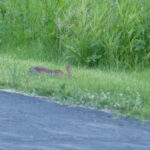
-
Bunnies enjoy clover.
-
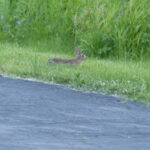
-
Watchful










































